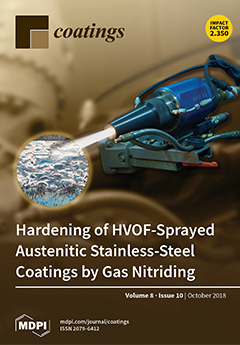A colloidal route was exploited to synthesize TiO
2 anisotropic nanocrystal rods in shape (TiO
2 NRs) with a surface chemistry suited for their dispersibility and processability in apolar organic solvents. TiO
2 NRs were dispersed in chloroform and n-heptane, respectively, and the
[...] Read more.
A colloidal route was exploited to synthesize TiO
2 anisotropic nanocrystal rods in shape (TiO
2 NRs) with a surface chemistry suited for their dispersibility and processability in apolar organic solvents. TiO
2 NRs were dispersed in chloroform and n-heptane, respectively, and the two resulting formulations were investigated to identify the optimal conditions to achieve high-quality TiO
2 NR-based coatings by the spray-coating application. In particular, the two types of TiO
2 NR dispersions were first sprayed on silicon chips as a model substrate in order to preliminarily investigate the effect of the solvent and of the spraying time on the morphology and uniformity of the resulting coatings. The results of the SEM and AFM characterizations of the obtained coatings indicated n-heptane as the most suited solvent for TiO
2 NR dispersion. Therefore, an n-heptane dispersion of TiO
2 NRs was sprayed on a highly porous limestone—Lecce stone—very commonly used as building material in historic constructions and monuments present in Apulia Region (Italy). A comprehensive physical-chemical investigation of the TiO
2 NR based treatment on the surface of the stone specimens, including measurements of colour variation, static contact angle, water transfer properties, and morphological characterization were performed. Finally, the photocatalytic properties of the coatings were assessed under solar irradiation by using Lecce stone specimens and Methyl Red as a model target compound. The obtained results demonstrated that TiO
2 NRs based coatings can be successfully applied by spray-coating resulting in an effective photocatalytic and hydrophobic treatment, which holds great promise as a material for the environmental protection of architectural stone in the field of cultural heritage conservation.
Full article





